A Deep Dive into Dubai Maritime City Master Plan
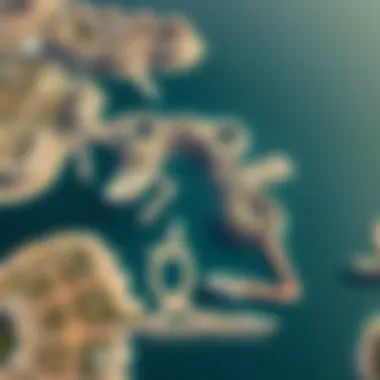
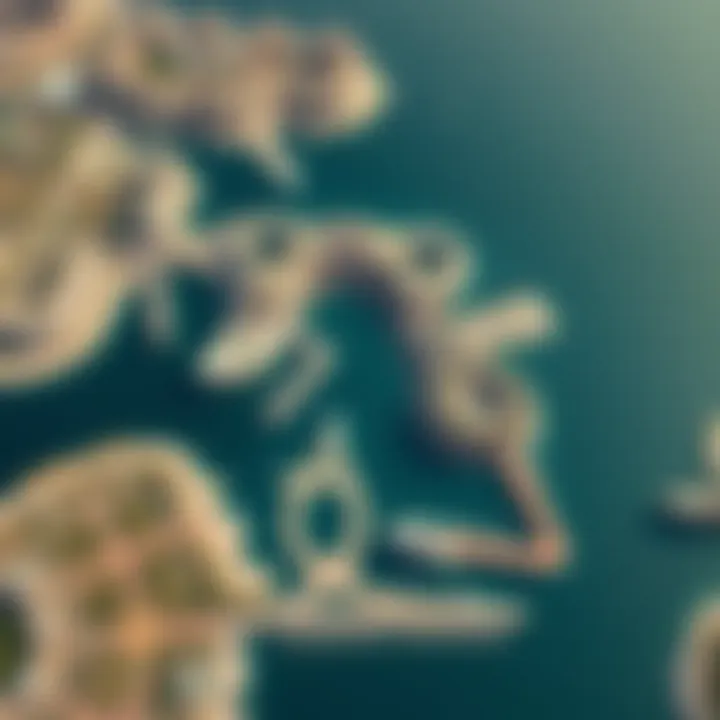
Intro
The Dubai Maritime City Master Plan is poised to redefine the maritime landscape and urban environment in one of the world’s most dynamic cities. As Dubai continues to embrace innovation and development, this detailed plan highlights the integration of maritime activities within an urban setting. Whether you're an investor eyeing growth opportunities or a resident seeking a vibrant community, grasping the significance of this initiative is vital.
The plan encompasses a multifaceted approach that combines economic vitality with sustainable urban living. It serves as a bridge between maritime industries and real estate development, facilitating not just growth but the evolution of a lifestyle that caters to a diverse population. Let’s delve deeper into the insights that frame this development and understand its market implications.
Market Insights
Current Trends in Dubai Real Estate
The real estate market in Dubai is an ever-evolving entity, reflecting a blend of domestic dynamics and global influences. Recent trends indicate a significant shift towards mixed-use developments. Investors are increasingly drawn to properties that offer both residential and commercial opportunities. The site of the Dubai Maritime City is strategically positioned to attract investors looking for prime real estate that caters to a growing expat community and affluent residents.
- Increase in Demand: With a rise in population, particularly among expatriates, the demand for high-quality housing is surging.
- Sustainability Initiatives: There’s a marked focus on eco-friendly building practices in light of global environmental concerns.
- Government Support: The recently introduced regulations are bolstering investor confidence and offering various incentives for overseas buyers.
Investment Opportunities in Key Areas
Investors are always on the lookout for hotspots, and the Dubai Maritime City stands out prominently. This master plan is not just about constructing buildings; it’s about cultivating a thriving ecosystem where businesses can flourish. Key areas include:
- Commercial Zones: Designed to host maritime and maritime-related businesses, these spaces come with advanced infrastructural support.
- Residential Units: Luxurious apartments and villas are designed with modern amenities, catering to both affluent residents and families.
- Recreational Facilities: Access to waterfronts and parks enhances community living, making it a compelling choice for lifestyle-oriented investors.
"The future of urban maritime centers is at our doorstep, and Dubai is ready to take the helm."
Investing in such a strategically envisioned space opens the door to lucrative returns and a multi-faceted lifestyle, merging business and leisure seamlessly.
Lifestyle Features
Luxury Living and Amenities
The Dubai Maritime City is envisioned not just as a commercial hub, but also as a beacon of luxury living. Residents can expect:
- High-Quality Interiors: Thoughtful designs tailored to maximum comfort and aesthetic appeal.
- State-of-the-Art Facilities: From fitness centers to infinity pools, every amenity is geared toward enhancing quality of life.
- Proximity to Essential Services: With schools, hospitals, and shopping centers nearby, convenience is key.
Cultural Attractions and Experiences
Beyond just a living space, the development integrates cultural elements that reflect the spirit of Dubai. Residents will have easy access to art galleries, theaters, and cultural festivals that foster community engagement. The rich tapestry of traditions is woven into the fabric of everyday life, providing a unique environment for all who call it home.
As Dubai Maritime City unfolds, it promises not just a place to live or work, but a landscape enriched with opportunities that blend urban sophistication with maritime heritage. Understanding these layers will undoubtedly assist potential home owners and investors in making informed decisions.
Intro to Dubai Maritime City
Dubai Maritime City (DMC) stands as a lighthouse of ambition within the broader framework of urban development and maritime innovation in the UAE. Its conception is intricately woven with the vision of transforming Dubai into a premier global maritime hub, which has implications that stretch far beyond its immediate geographic constraints. While some may view DMC merely as a large parcel of land designated for new construction, its potential reverberates through economic growth, the enhancement of the maritime sector, and urban revitalization. With state-of-the-art infrastructure and strategic planning at its core, the DMC not only aims to attract international businesses but also to host a vibrant community.
Overview of the Maritime Sector
The maritime sector in Dubai has always been a critical component of its economy, showcasing the city’s historic relationship with trade and commerce. By establishing DMC, authorities seek to create a consolidated maritime cluster—a one-stop-shop for maritime services that includes ship building, repair facilities, and marine logistics. In essence, DMC is expected to become the beating heart of a sector that contributes significantly to Dubai’s GDP. Maritime tourism, cargo handling, and shipping operations are integral parts of this lucrative industry, and the master plan outlines specific areas for each of these activities—ultimately designed to create synergies among them.
The design encourages a smooth flow of operations, facilitating better collaboration among various stakeholders, including private companies, governmental entities, and international maritime organizations. As the plan unfolds, the emphasis on sustainability and eco-friendliness is expected to augment Dubai's reputation, not only enhancing business but also contributing positively to the local community.
Location and Accessibility
DMC is strategically situated in close proximity to Jebel Ali Port and Dubai International Airport, making it highly accessible not just for sea travel but for the transport of goods by air. This location is crucial for both local and international trade, providing an advantageous position for businesses to establish operations that can reach markets quickly. The connectivity to major road networks further enhances its appeal, allowing for easy movement of freight and personnel.
Access to DMC is not limited to logistical ease; it also features a range of residential options that promote a lifestyle blend of work and leisure. With plans for waterfront promenades, parks, and mixed-use developments, the location stands to attract expatriates and locals alike. Residents can enjoy the seaside while being mere minutes from the bustling urban environment of Dubai.
"The essence of Dubai Maritime City's master plan lies in its brilliant fusion of strategic location, economic potential, and lifestyle choices."
Investors and stakeholders looking to tap into this burgeoning sector will find that the accessibility of DMC makes it an attractive option for various ventures. With ongoing infrastructure projects and strong governmental backing, the master plan for Dubai Maritime City is a promising reflection of Dubai’s commitment to maintaining its status as an international trade nexus.
Strategic Importance of the Master Plan
Understanding the strategic importance of the Dubai Maritime City Master Plan involves appreciating how it interconnects various aspects of urban development, economic growth, and global positioning. At its core, the Master Plan aims to create a robust maritime hub that not only enhances the local economy but also significantly boosts Dubai's status on the world stage.
One of the key elements is the way this project contributes to the maritime industry. By design, it focuses on making Dubai a focal point for shipping, trade, and marine services. This strategic positioning is not just beneficial for the city but extends advantages to regional and international stakeholders as well. The long-term vision includes creating approximately 2.5 million square meters dedicated to maritime activity.
Moreover, the Master Plan emphasizes the importance of creating a mixed-use development that accommodates both commercial and residential spaces. This strategy not only caters to the needs of investors and businesses but also addresses the evolving lifestyle of residents looking for modern living conditions amid a thriving economic landscape.


"Building a maritime city today is akin to securing a pivotal position in tomorrow’s global economy. It's not just about today’s needs; it’s about foresight and positioning for the future."
The economic implications of the Master Plan are pronounced. It serves to attract foreign investment, with numerous opportunities in real estate and commercial ventures. The careful planning promotes a vibrant marketplace that could potentially lead to job creation in various sectors—from logistics to tourism. Investors are likely to see a promising return on investment as the area transforms into a bustling economic zone.
Economic Implications
The economic implications of the Dubai Maritime City Master Plan are vast and worthy of attention. First and foremost, this initiative is a catalyst for numerous sectors that can benefit from maritime activities. With the development spanning various domains—like shipbuilding, repair, and marine services—the Master Plan sets a solid foundation for growth.
- Job Creation: As new businesses establish footholds in the area, job opportunities will arise. Residents and expatriates alike can find working prospects in various industries linked to the maritime sector.
- Revenue Generation: From tourism to trade, the revenue streams generated via the maritime city will lead to enhanced economic stability. The city is envisioned to bring in millions in various forms of taxable income, contributing to the overall budget.
- Investment Opportunities: Investors will find numerous advantages, whether they are in real estate, retail, or service-based industries. The influx of businesses alongside residential avenues opens doors for partnerships and collaborative ventures.
Enhancing Global Competitiveness
The future of Dubai’s global standing hinges significantly on its maritime capabilities. The enhanced global competitiveness through the development of the Dubai Maritime City anchors on a multitude of strategic initiatives. A few vital points to consider include:
- Strategic Partnerships: By fostering relationships with key players in the maritime industry globally, Dubai can tap into international markets more effectively.
- Technology Integration: The Master Plan embraces smart technology to improve operational efficiency. This includes sustainable practices that will set benchmarks in environmental stewardship。
- Infrastructure Investments: To truly enhance global competitiveness, a solid infrastructure backbone is necessary. The plan includes investments in ports, logistics, and transportation, ensuring that the city keeps pace with or outperforms global maritime hubs.
In summary, the strategic importance of the Dubai Maritime City Master Plan encapsulates a well-thought-out approach to boosting economic and competitive standing. It underscores a commitment to creating a thriving maritime environment that benefits investors, residents, and global partners alike.
Components of the Master Plan
The components of the Dubai Maritime City Master Plan form the backbone of this ambitious initiative. These elements are not merely standalone features but are intricately linked to one another, working harmoniously to create a vibrant, functional, and sustainable urban environment. Each component contributes to the overall vision, enhancing the city's maritime capabilities while catering to the growing needs of investors, residents, and visitors alike.
Residential Developments
One of the cornerstones of the Master Plan is the residential developments envisioned within the Dubai Maritime City. These residential spaces aim to blend modern living with maritime aesthetics, offering a unique lifestyle unlike anything else in Dubai. Think of waterfront apartments with panoramic views, spacious villas adorned with local architectural influences, and community-centric developments that foster a sense of belonging.
The design of these residential areas focuses heavily on maximizing both comfort and convenience. With amenities like swimming pools, gyms, and parks, residents can enjoy the luxury of urban life paired with the tranquility of waterfront living. The topography of the area is tailored to ensure easy access to key facilities, including schools, hospitals, and shopping centers.
Here are some specific benefits:
- Diverse Living Options: From high-rise towers to serene townhouses, there’s an array of choices to cater to different lifestyles.
- Community Atmosphere: Incorporating communal spaces helps in building a close-knit neighborhood, vital for social interactions.
- Prime Location: Proximity to Dubai's major transport links brings added convenience, with links to both land and sea.
Commercial Spaces
Commercial spaces are another critical element of the Dubai Maritime City Master Plan, designed to serve both local entrepreneurs and multinational corporations. These areas are destined to become hubs of commerce, innovation, and trade, complementing the residential facets by providing jobs and contributing to Dubai's economy.
The focus here is to attract businesses that align with maritime industries and services, such as shipping, logistics, and tourism. Additionally, retail outlets, restaurants, and entertainment venues will create a bustling atmosphere, turning this region into a prominent business district.
Here’s what sets these commercial zones apart:
- Economic Growth: The commercial spaces are set to boost local and foreign investments, stimulating the economy further.
- Accessibility: Being near key transport routes, they provide ease of access for both employees and customers, an essential characteristic of any thriving business area.
- State-of-the-Art Facilities: With high-tech infrastructure and versatile spaces, these areas are adaptable to the evolving needs of various enterprises.
Maritime Infrastructure
Last but not least, the maritime infrastructure laid out in the Master Plan is what truly sets Dubai Maritime City apart. This infrastructure serves as the linchpin for a thriving maritime ecosystem, reinforcing Dubai’s status as a global maritime center.
The planned developments include well-developed docking facilities, ship maintenance yards, and logistics centers aimed at serving both local and international shipping needs. For instance, spacious marinas enable leisure crafts alongside commercial shipping operations, catering to both tourists and residents looking to navigate the emirate’s stunning coastlines.
Some highlights include:
- Enhanced Capacity: The infrastructure is designed to significantly increase the capacity for shipping and logistics operations.
- Environmental Considerations: Efforts to minimize disruptions to local ecosystems are prioritized, ensuring that marine life remains protected even as development progresses.
- Support Facilities: Adequate provisions for marine-related services, such as repairs and supplies, will encourage maritime activities and promote growth in related industries.
The Dubai Maritime City Master Plan represents a significant investment into the future of urban maritime solutions, embodying a vision that encompasses environment, economy, and community.
Environmental Considerations
The environmental realities surrounding the Dubai Maritime City Master Plan hold considerable importance and merit thorough examination. As urbanization and maritime development converge, there emerges a need to strike a balance between progress and ecological stewardship. This segment will delve into both the sustainability initiatives set forth in the master plan and their anticipated effects on marine ecosystems.
Sustainability Initiatives
Dubai Maritime City aims to implement several sustainability initiatives that help mitigate environmental impacts while fostering innovation in ecological conservation. Emphasizing green building practices, these initiatives are designed to ensure longevity and minimize carbon footprints.
- Use of Renewable Energy: Solar panels and wind turbines are integral parts of the design, significantly reducing dependence on non-renewable energy sources.
- Water Management Solutions: Advanced systems for water recycling and rainwater harvesting will play a pivotal role in ensuring sustainable water usage across the community.
- Waste Management Programs: Initiatives focusing on reducing waste generation and enhancing recycling efforts are crucial. The plan proposes strict recycling protocols for both residential and commercial sectors.
- Green Spaces and Biodiversity: Plans include ample green areas, parks, and even waterfront promenades, serving to improve air quality and promote biodiversity.
By promoting these measures, the master plan endeavors to fulfill not just local, but also global sustainability standards. Addressing environmental considerations is not merely a preference; it has become an essential part of urban planning and development in today's increasingly eco-conscious society.
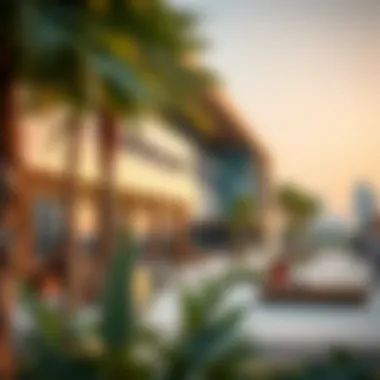
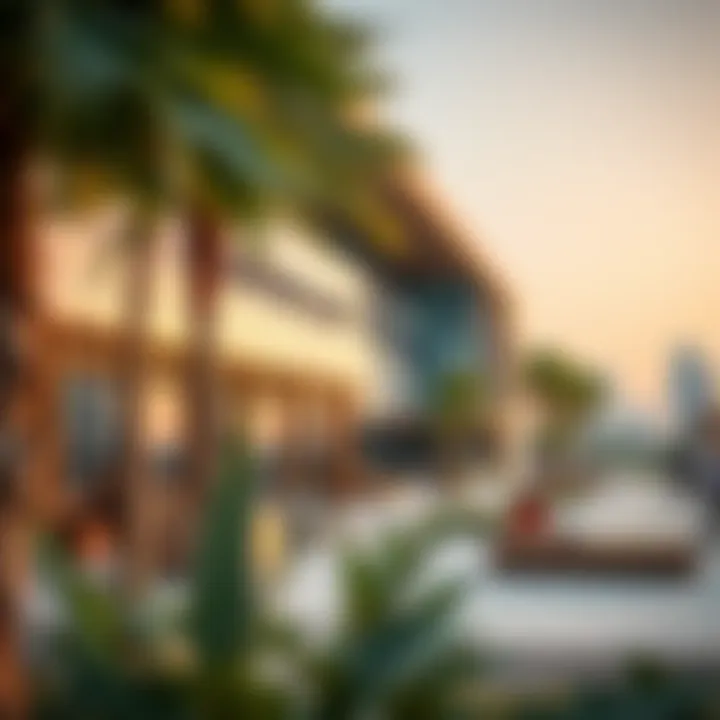
Impact on Marine Life
The coastal region around Dubai Maritime City is rich in biodiversity, serving as a habitat for various marine species. As such, the impact of development on marine life is a pressing concern that must be addressed thoughtfully. The intention of the master plan is to develop infrastructure that respects and preserves the marine ecosystem while also enhancing the maritime industry.
Urban Design and Architecture
Urban design and architecture play a pivotal role in shaping Dubai Maritime City, ensuring that it not only meets the functional requirements of its residents and businesses but also enhances the overall aesthetic and cultural context of the area. The master plan emphasizes a seamless blend of cutting-edge design with practical applications, which ultimately benefits investors, homeowners, and expatriates alike. By fostering an environment that prioritizes both innovation and sustainability, Dubai aims to set a benchmark for future urban developments.
Innovative Design Strategies
The master plan introduces several innovative design strategies that focus on sustainability and efficiency. These strategies are crafted to tackle the unique challenges presented by Dubai's climatic conditions while also appealing to modern sensibilities. Among the most notable tactics are:
- Mixed-Use Developments: Incorporating residential, commercial, and recreational spaces within the same area encourages community interaction and reduces the need for transportation, thereby minimizing the carbon footprint.
- Green Architecture: Utilizing eco-friendly materials and incorporating green roofs, solar panels, and natural ventilation systems ensures that buildings not only blend harmoniously with their environment but also contribute positively to it. This is particularly valuable for eco-conscious investors and sustainability advocates.
- Smart Technology Integration: Incorporating smart technologies allows buildings to operate more efficiently, enhancing occupant comfort while conserving energy. This includes advanced climate control systems, automated lighting, and integrated security features that appeal to tech-savvy residents and business owners.
- Public Spaces: Creating inviting public areas equipped with parks, waterfronts, and recreational facilities promotes outdoor activities and enhances the quality of life. Such spaces are crucial in attracting tourists and expatriates, reinforcing the community aspect of Dubai Maritime City.
"Modern urban design transcends mere aesthetics; it embodies a commitment to functionality, sustainability, and community."
Integration with Local Culture
To genuinely reflect the essence of Dubai, integrating local culture within the architectural narrative is key. The master plan has been developed with a keen awareness of the region's rich history and traditions. Some essential aspects of this integration include:
- Architectural Aesthetics: By incorporating elements reminiscent of traditional Arabian architecture, such as intricate carvings and large courtyards, the designs honor local heritage while maintaining a contemporary outlook.
- Cultural Spaces: The inclusion of museums, galleries, and cultural centers not only promotes local art but also provides a platform for cultural exchange. Such spaces serve as a bridge connecting the local population with expatriates and tourists, fostering a deeper understanding and appreciation of the region's heritage.
- Community Engagement: Involving local communities during the design phase helps to ensure that the resulting urban layout resonates with the daily lives and aspirations of the people. This participatory approach can contribute to higher levels of satisfaction and ownership among residents.
- Culinary and Retail Experiences: Streetscapes designed to support local food vendors and artisans can enhance the vibrant atmosphere of Dubai Maritime City. This not only supports local entrepreneurs but provides residents and visitors with an authentic taste of Dubai's culinary landscape.
The thoughtful integration of innovative design strategies and local culture into the fabric of Dubai Maritime City plays a crucial part in fostering a thriving, sustainable urban environment. This approach not only supports the economic growth of the region but also creates a hum of activity that enriches the lives of all who inhabit or visit this dynamic space.
Key Stakeholders and Partnerships
Understanding the dynamics of key stakeholders and partnerships is absolutely pivotal in the context of the Dubai Maritime City Master Plan. The intricate web of relationships that tie together governmental bodies, private entities, and community stakeholders creates a rich environment for progress and innovation. As we delve into this section, it becomes clear that each group plays a crucial role in ensuring the success of this ambitious project.
Role of Government Entities
Government involvement is often the backbone of large-scale urban developments, and the Dubai Maritime City Master Plan is no exception. Entities such as the Dubai Municipality and various regulatory bodies oversee planning, zoning, and compliance with environmental standards. The local government’s strategic vision certainly doesn't just end with laws and regulations; rather, it actively shapes the infrastructure and community services that bolster economic growth.
- Regulatory Framework: Government entities work to ensure the development is aligned with city planning laws. This framework addresses everything from the height of buildings to land use, which is crucial in a space as diverse as Dubai Maritime City.
- Investment Incentives: By offering tax breaks or subsidies to investors, the government creates a welcoming atmosphere. These incentives can seriously tip the scales for investors contemplating involvement in real estate ventures.
- Public Safety and Services: Active government participation ensures that necessary public services, like water, electricity, and waste management systems, are implemented seamlessly within the new developments.
In essence, the government’s role transcends mere oversight; it’s a partnership of shared goals, working to create a thriving economic hub that stands out globally.
Private Sector Involvement
The private sector’s contribution is equally vital in advancing the aspirations set forth by the Master Plan. From real estate developers to maritime service providers, the interplay between public interests and private investments reflects a mutual understanding of potential prosperity.
- Investment Capital: Private enterprises typically bring in the capital needed for large-scale construction and development projects. They also infuse innovation and agility that can accelerate progress in line with market demands.
- Expertise and Innovation: Many successful developments rely on the expertise offered by private stakeholders, ranging from cutting-edge construction techniques to state-of-the-art design. For instance, companies specializing in maritime engineering contribute essential knowledge to ensure infrastructure resiliency.
- Job Creation: The private sector not only invests but also generates significant employment opportunities, both during construction and in ongoing operations of businesses once the development is complete. This creates a ripple effect, benefiting the local economy at large.
Investment Opportunities
Investment opportunities arising from the Dubai Maritime City Master Plan present an enticing prospect for a variety of stakeholders including investors, homeowners, expatriates, and real estate agents. As a strategic waterfront development, it provides a unique blend of residential, commercial, and maritime spaces that cater to diverse needs while promising significant economic returns. In the context of a bustling Dubai, where market dynamics are continually shifting, the opportunities linked to the Master Plan are particularly noteworthy for those wishing to stake their claim in this expansive growth.
Real Estate Developments
Real estate developments in Dubai Maritime City are not just about constructing buildings; it is about creating a vibrant community that offers a balanced lifestyle. Developers are focusing on striking designs, high-quality materials, and sustainable practices, which resonate with the aspirations of modern city dwellers. Residential properties vary from upscale apartments to luxurious villas, each designed to provide stunning views of the waterways or the city skyline.
Moreover, the integration of mixed-use developments offers residents convenient access to shops, offices, and recreational areas, making everyday life more convenient. This community-centric approach not only enhances the living experience but also boosts property value significantly over time. With an increasing number of expatriates looking to make Dubai their home, the demand for residential spaces is set to grow, providing strong returns for early investors.
"Real estate in Dubai is more than just buying a property; it’s about acquiring a lifetime asset in one of the most dynamic markets in the world."
Key considerations for investors in this sector include:
- Location: Proximity to business hubs and transport links adds value.
- Market Trends: Staying informed about fluctuations can lead to better investment choices.
- Rental Yield: The potential income generated can offer a solid return on investment.
Commercial Ventures
As the maritime sector expands, commercial ventures in Dubai Maritime City are blossoming. The Master Plan lays the groundwork for a bustling commercial landscape, consisting of office spaces, retail outlets, and maritime-related businesses. This area is expected to become a magnet for maritime trade and tourism, opening the door for businesses focused on shipping, logistics, and waterfront activities.
Investing in commercial ventures within this vicinity not only ensures integration with the maritime ecosystem but also caters to a rapidly growing clientele. With businesses seeking locations that can provide not just space but a vibrant market, the potential for lucrative commercial opportunities in this part of Dubai is robust.
Potential benefits for commercial investors include:
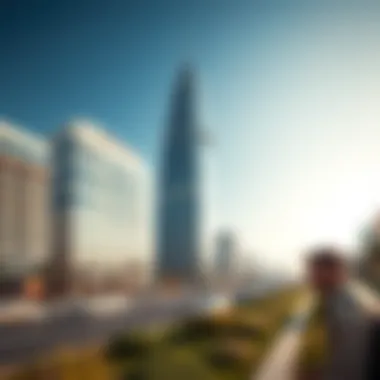
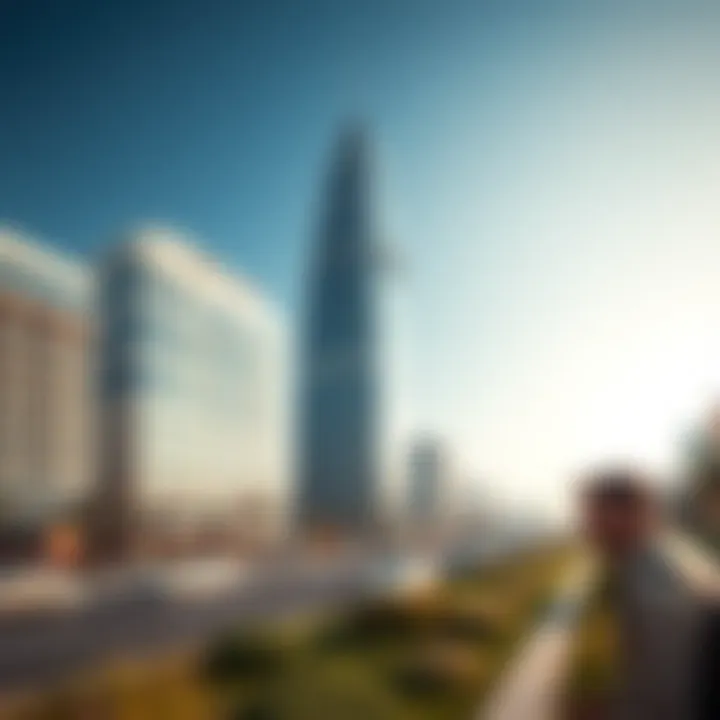
- Diversified Portfolio: Investing in multiple sectors can reduce risks.
- Increased Foot Traffic: With residential developments nearby, businesses can benefit from a constant influx of potential customers.
- Supportive Infrastructure: Facilities like ports, transport systems, and logistical hubs enhance operational efficiency.
In sum, whether one is looking to dive into real estate or explore commercial ventures, the Dubai Maritime City Master Plan presents a wealth of options ripe for exploration. With its strategic location, diversified opportunities, and potential for high returns, it is indeed an attractive proposition for savvy investors.
Challenges and Risks
The Dubai Maritime City Master Plan is an ambitious endeavor aimed at transforming Dubai into a global maritime hub. However, the path to success isn’t all smooth sailing. Investing in such large-scale projects naturally invites various challenges and risks that both stakeholders and investors must carefully consider. Recognizing these risks not only aids in strategic planning but also allows for preparedness against potential pitfalls that could derail the plan or affect overall investments.
Market Volatility
Market volatility stands as a significant concern in the context of this master plan. Fluctuating market conditions can have a dampening effect on investors' confidence. Given the rapid evolution of the maritime industry, accompanied by unpredictable global economic trends, potential investors must stay alert.
- Property values may experience sharp changes. Economic downturns or community shifts can lead to decreased demand for residential and commercial spaces.
- The risk of over-investment in certain sectors may implement bottlenecks if the market cannot absorb the influx of developments.
- An unpredictable supply chain can hinder construction timelines, resulting in increased costs and delayed revenue generation.
Moreover, the region’s heavy reliance on oil and trade means it is vulnerable to international price fluctuations and policy changes. Reliance on a singular sector could spell trouble, making a diversified approach essential.
Environmental Concerns
Equally critical to the success of the Dubai Maritime City Master Plan are the burgeoning environmental concerns. As ecological sustainability is gaining paramount importance globally, stakeholders must factor in potential environmental risks associated with the project.
- Habitat disruption is a significant worry. The construction of extensive infrastructures may disturb local marine ecosystems, displacing various species and altering the natural balance.
- Water quality and pollution risks should not be brushed under the rug. Increased maritime activities could lead to oil spills or waste mismanagement, directly impacting marine life and coastal beauty.
- The project must also address the long-term sustainability of water usage for construction and later for residents and commercial operators, as this is vital in a desert environment.
"Sustainable practices must be woven into the fabric of development to ensure that progress is not achieved at the expense of our environment."
The Dubai Maritime City Master Plan holds great promise but requires careful navigation through these challenges to fully realize its potential. Stakeholders need to engage with these concerns proactively, ensuring effective risk management frameworks are in place to safeguard the expected benefits of this maritime hub.
Future Trends and Projections
Understanding the future trends and projections related to Dubai Maritime City is crucial for investors, homeowners, and expatriates keen on navigating this evolving maritime landscape. These trends not only forecast the growth trajectory but also highlight the underlying considerations that shape this ambitious urban project. Here, we will dissect two key areas: the growth potential of the maritime industry and the strategies for adapting to global changes that influence this growth.
Growth Potential of the Maritime Industry
The maritime industry is no longer just about shipping goods; it's a multifaceted domain encompassing logistics, tourism, and related sectors. The growth potential here is immense, driven in part by increasing global trade and a surge in demand for maritime services. Dubai Maritime City stands to benefit significantly due to its strategic location, modern infrastructure, and nurturing of businesses within the maritime ecosystem.
Factors propelling this growth include:
- Expansion of Trade Routes: The ongoing investment in modernization of shipping lanes and ports enhances trade efficiency, making maritime solutions more attractive.
- Technological Advances: Innovations in automation and eco-friendly technologies are reshaping industries. For instance, advancements in autonomous vessels and smart logistics systems might capitalise on the increased emphasis on zero-emission solutions.
- Tourism and Recreation: The rise of leisure boating and yachting has positioned Dubai as a prime destination for maritime tourism, further reinforcing its maritime reputation.
As a result, stakeholders in Dubai Maritime City can anticipate increased job opportunities and a flourishing business environment. The integration of these factors allows for a promising horizon, where collaboration among public and private entities will likely spur advancements that attract further investment.
Adapting to Global Changes
Global dynamics are ever-shifting, often impacting local markets and industries in unexpected ways. Dubai Maritime City's ability to adapt to these changes is central to its long-term success.
Consider the following aspects:
- Environmental Regulations: With the world increasingly focused on sustainability, stricter regulations are likely to emerge around maritime operations. Dubai Maritime City must align its initiatives to not only comply but lead in sustainable practices, potentially setting benchmarks for others to follow.
- Economic Shifts: The fluctuations in global economies can sway demand for maritime services, affecting everything from cargo shipping to yacht sales. Being nimble and responsive to these shifts will place Dubai Maritime City in a favorable position.
- Technological Innovations: The digital age is transforming the maritime space. From blockchain use in supply chains to advanced data analytics for operational efficiency, embracing these technologies becomes non-negotiable.
In essence, adaptability is key. The narrative surrounding Dubai Maritime City is one that embraces flexibility and forward-thinking. Companies and stakeholders prepared for an evolving environment stand to flourish, tapping into both local and international maritime markets.
"Investors must keep their finger on the pulse of global changes to navigate the waves of opportunity in the maritime sector."
Culmination
The future of Dubai Maritime City lies in its well-structured Master Plan, which serves not just as a blueprint for urban growth but as a manifestation of Dubai's ambition to be a global maritime hub. This article delves into various critical aspects of the Master Plan, shedding light on its economic significance, environmental sustainability, and the innovative design strategies it employs.
A standout feature of the plan is its integration of residential, commercial, and maritime infrastructure, forming a harmonious blend that prioritizes both utility and aesthetic appeal. The potential for economic growth is substantial, presenting opportunities for diverse stakeholders, including investors and local entrepreneurs.
The emphasis on sustainability initiatives is particularly noteworthy. There is a clear aim to minimize environmental impacts while still fostering robust urban development. This dual focus on development and preservation is not only beneficial for the ecosystem but also positions Dubai Maritime City as a paragon of modern urban planning.
"In a rapidly changing world, Dubai's Maritime City is a beacon of innovation and opportunity."
Summary of Key Insights
- Economic Growth: The Master Plan is foreseen as a catalyst for economic stimulation, which can potentially lead to the creation of thousands of jobs and a boost in local businesses.
- Sustainability: Efforts in sustainability are not mere afterthoughts but integrated at every level of the design and execution phases. This ensures that development does not compromise environmental integrity.
- Cultural Integration: The architectural designs reflect local culture while incorporating modern elements, bridging the gap between tradition and progress.
- Investment Potential: The allure of Dubai Maritime City is not only in its bold designs but also in its promising return on investment, making it a hot spot for real estate and commercial ventures.
Call to Action for Investors and Stakeholders
For investors and stakeholders, the Dubai Maritime City Master Plan represents a golden opportunity. Here’s how you can engage:
- Explore Investment Opportunities: Assess the various investment avenues available, especially in the residential and commercial sectors.
- Collaborate with Local Entities: Partner with local businesses or governmental bodies to streamline operations and foster community relationships.
- Contribute to Sustainability Goals: Companies focusing on eco-friendly practices can stand to benefit from the growing emphasis on sustainability in urban development.
- Stay Informed: Regularly update yourself on trends and advancements in the city; subscribing to updates from local government initiatives or following related forums can be beneficial.















